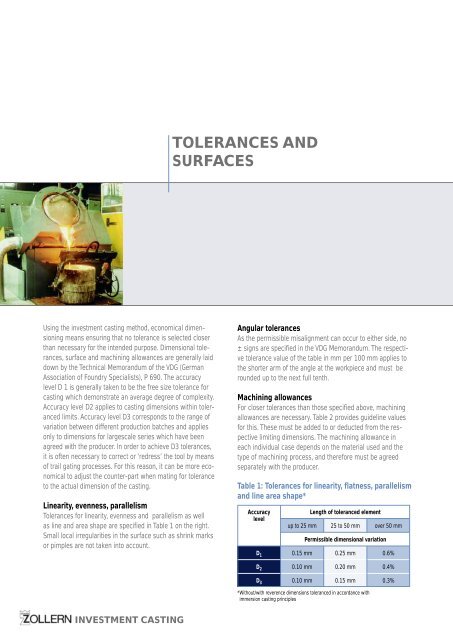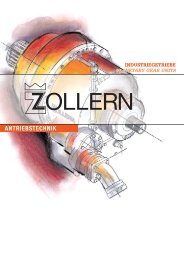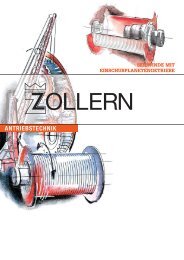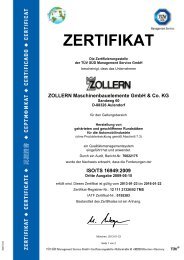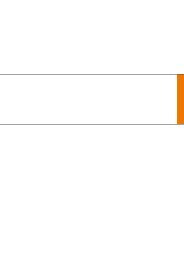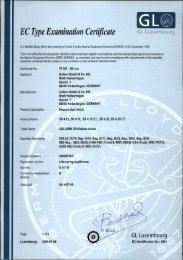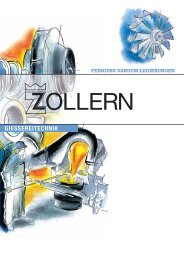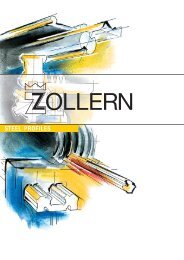FOUNDRY TECHNOLOGY - Zollern
FOUNDRY TECHNOLOGY - Zollern
FOUNDRY TECHNOLOGY - Zollern
You also want an ePaper? Increase the reach of your titles
YUMPU automatically turns print PDFs into web optimized ePapers that Google loves.
TOLERANCES AND<br />
SURFACES<br />
Using the investment casting method, economical dimensioning<br />
means ensuring that no tolerance is selected closer<br />
than necessary for the intended purpose. Dimensional tolerances,<br />
surface and machining allowances are generally laid<br />
down by the Technical Memorandum of the VDG (German<br />
Association of Foundry Specialists), P 690. The accuracy<br />
level D 1 is generally taken to be the free size tolerance for<br />
casting which demonstrate an average degree of complexity.<br />
Accuracy level D2 applies to casting dimensions within toleranced<br />
limits. Accuracy level D3 corresponds to the range of<br />
variation between different production batches and applies<br />
only to dimensions for largescale series which have been<br />
agreed with the producer. In order to achieve D3 tolerances,<br />
it is often necessary to correct or ‘redress’ the tool by means<br />
of trail gating processes. For this reason, it can be more economical<br />
to adjust the counter-part when mating for tolerance<br />
to the actual dimension of the casting.<br />
Linearity, evenness, parallelism<br />
Tolerances for linearity, evenness and parallelism as well<br />
as line and area shape are specified in Table 1 on the right.<br />
Small local irregularities in the surface such as shrink marks<br />
or pimples are not taken into account.<br />
Angular tolerances<br />
As the permissible misalignment can occur to either side, no<br />
± signs are specified in the VDG Memorandum. The respective<br />
tolerance value of the table in mm per 100 mm applies to<br />
the shorter arm of the angle at the workpiece and must be<br />
rounded up to the next full tenth.<br />
Machining allowances<br />
For closer tolerances than those specified above, machining<br />
allowances are necessary. Table 2 provides guideline values<br />
for this. These must be added to or deducted from the respective<br />
limiting dimensions. The machining allowance in<br />
each individual case depends on the material used and the<br />
type of machining process, and therefore must be agreed<br />
separately with the producer.<br />
Table 1: Tolerances for linearity, flatness, parallelism<br />
and line area shape*<br />
Accuracy<br />
level<br />
Length of toleranced element<br />
up to 25 mm 25 to 50 mm over 50 mm<br />
Permissible dimensional variation<br />
D 1 0.15 mm 0.25 mm 0.6%<br />
D 2 0.10 mm 0.20 mm 0.4%<br />
D 3 0.10 mm 0.15 mm 0.3%<br />
*Without/with reverence dimensions toleranced in accordance with<br />
immersion casting principles<br />
INVESTMENT CASTING


